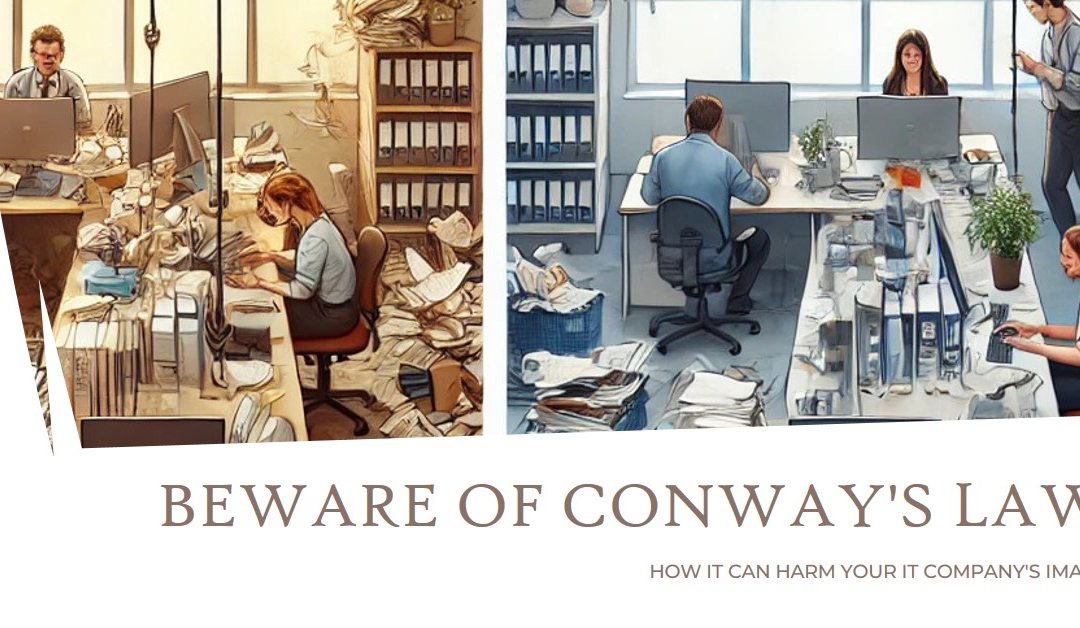Conway’s Law, proposed by programmer and scientist Melvin Conway in 1967, states that “any organization that designs a system will inevitably produce a design whose structure is a copy of the organization’s communication structure.” In other words, the systems and software developed by a company directly reflect how its teams and departments communicate with each other. This concept has deep implications in the IT sector, as depending on how this communication happens, a company’s image may suffer negative repercussions in the market.
Fragmentation and lack of cohesion in products
One of the key problems that Conway’s Law highlights is the fragmentation of systems and products, which results from teams working in isolation. When different IT departments or development teams fail to collaborate effectively, the products mirror this lack of cohesion.
Imagine an IT company developing a complex software. If internal teams work in silos, each with their own goals and communication methods, the final product may resemble a patchwork of disconnected modules that don’t integrate smoothly. This could result in a clunky system that’s difficult to use and prone to bugs, harming the customer experience and, consequently, the company’s reputation in the market.
Risks to scalability and innovation
Companies that ignore Conway’s Law run the risk of creating systems that are difficult to scale or modify. If the organizational structure and communication channels are rigid and fragmented, developing new features or adapting to market changes becomes a herculean task.
Over time, this difficulty in innovating and scaling can seriously harm a company’s competitive image. In the IT sector, where rapid innovation and adaptability are essential, an organization that cannot keep up with market trends or provide continuous improvements to its products will soon be seen as outdated and uncompetitive. This can drive away both clients and potential partners.
Impact on customer satisfaction
Another significant reflection of Conway’s Law on a company’s image is the direct impact it can have on customer satisfaction. When a software or system is designed by a disorganized company, with ineffective communication between its teams, the final product is likely to have inconsistencies. For example, a user interface may not meet expectations because different teams responsible for various parts of the project failed to align their visions.
Customer dissatisfaction arises when they find that the product or service does not meet their expectations, either due to poor technical quality or a lack of integrated functionality. And, as we know, an unhappy customer tends to share their frustrations, especially in today’s hyper-connected world. This can damage the company’s reputation, resulting in a negative image in the market and even the loss of contracts.
Negative effect on employer branding
Conway’s Law can also affect how a company is perceived by its own employees and the job market. When internal communication is poor and teams work in isolation, it can create a demotivating work environment, where employees feel disconnected from the company’s overall goals. In a highly competitive IT market, where attracting and retaining talent is crucial, this internal perception of disorganization can harm the company’s “employer branding,” or how it’s viewed as a place to work.
If an organization is seen as a chaotic workplace with ineffective communication, the most qualified professionals may opt not to join the team, choosing companies with a clearer organizational structure and a collaborative environment instead. This not only affects the quality of the products and services offered but also compromises the company’s long-term growth.
How to mitigate the negative effects of Conway’s Law
To prevent Conway’s Law from negatively impacting a company’s image in the IT market, organizations should adopt practices to improve internal communication and foster a collaborative environment. This can include:
- Cross-functional teams: Form teams composed of members from different areas, who collaborate directly and share a clear understanding of the project’s global objectives.
- Open and transparent communication: Encourage the continuous exchange of information between different departments and teams to ensure everyone is aligned.
- Integrated project management tools: Use tools that facilitate communication and collaboration between team members, avoiding information silos.
- Organizational flexibility: Rigid communication structures should be reconsidered, allowing greater fluidity and adaptability to quickly respond to market demands.
Conclusion
Conway’s Law provides a powerful lens through which to understand communication challenges within IT companies. When ignored, it can negatively impact the organization’s image, affecting product quality, customer satisfaction, and the ability to innovate. Therefore, companies must adopt practices that mitigate these effects, promoting effective internal communication and ensuring that their organizational structures do not interfere with the development of efficient and competitive solutions.
Views: 351


